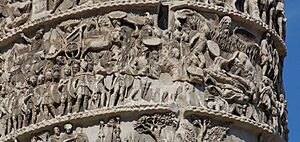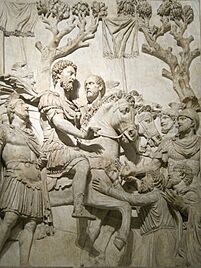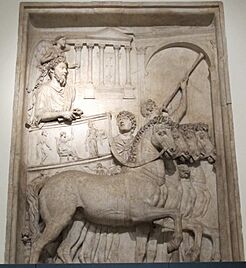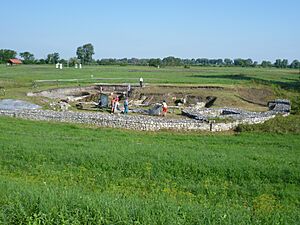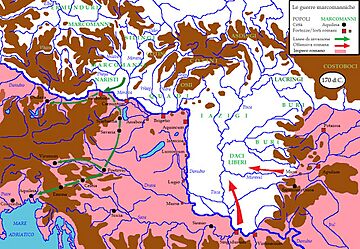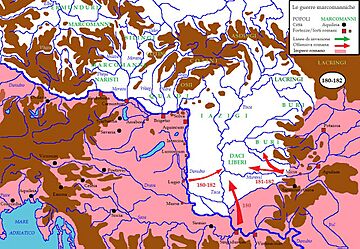Marcomannic Wars facts for kids
Quick facts for kids Marcomannic Wars |
|||||||||
|---|---|---|---|---|---|---|---|---|---|
| Part of the Roman–Germanic Wars | |||||||||
 A battle scene from the Column of Marcus Aurelius in Rome, showing the Marcomannic Wars (late 2nd century AD) |
|||||||||
|
|||||||||
| Belligerents | |||||||||
Full list of participating military units |
|
||||||||
| Commanders and leaders | |||||||||
| Imperial family: Marcus Aurelius Lucius Verus # Ti. Claudius Pompeianus Commodus Praetorian prefects: Titus Furius Victorinus Marcus Bassaeus Rufus Marcus Macrinius Vindex † P. Tarrutenius Paternus Field marshals (legati): Publius Helvius Pertinax Marcus Claudius Fronto † Marcus Didius Julianus Gaius Pescennius Niger Decimus Clodius Albinus M. Valerius Maximianus Lucius Gallus Julianus Gaius Vettius Sabinianus Titus Vitrasius Pollio |
|
||||||||
| Strength | |||||||||
|
977,000 | ||||||||
| Casualties and losses | |||||||||
| Moderate | Heavy | ||||||||
The Marcomannic Wars were a series of conflicts that lasted from about 166 AD to 180 AD. These wars involved the powerful Roman Empire fighting against several groups. The main enemies were the Germanic tribes called the Marcomanni and Quadi, and the Sarmatian tribe known as the Iazyges.
These battles happened along the Danube River. This river formed a long part of the Roman Empire's northeastern border in Europe. The fight against these Germanic and Sarmatian tribes took up most of the time that Roman emperor Marcus Aurelius was in charge. It was during these difficult campaigns that he began writing his famous book of philosophical thoughts, Meditations.
Why the Wars Started
Rome's Situation Before the Wars
Before these wars, the Roman Empire had been quite stable for many years. Emperor Antoninus Pius, who ruled before Marcus Aurelius, rarely left Italy. He also did not try to conquer new lands. This might have made other empires, like Parthia, think Rome was weaker.
A war between Rome and Parthia happened from 161 to 166 AD. Even though Rome won, it had a big, unexpected problem. The Roman soldiers returning from the war brought a terrible sickness with them. This was called the Antonine Plague. It killed millions of people, making the Roman Empire much weaker. However, Rome was strong and managed to recover.
Tribes on the Move
At the same time, big changes were happening in Central Europe. Tribes like the Goths started moving south. This put pressure on other Germanic tribes living near the Roman border. As a result, these Germanic tribes and other nomadic groups began to raid Roman lands. They crossed the northern border into areas like Gaul and across the Danube River.
Historians are not sure why these tribes suddenly moved. It could have been due to climate change or too many people in their lands. Some think the Germanic tribes might have worked together. They wanted to test Rome's strength and maybe create a large united Germanic empire. Before these wars, the Marcomanni and Quadi usually got along well with Rome. They even traded Roman goods. Rome wanted to control these areas but also trade with the tribes.
History of the Marcomannic Wars
First Marcomannic War: Early Invasions
By 161 AD, the pressure on Rome's borders was very high. Germanic tribes decided they needed to break into Roman lands to survive. From 162 to 165 AD, tribes like the Chatti and Chauci invaded Roman provinces. Rome pushed them back.
In 166 or 167 AD, about 6,000 Langobardi and Lacringi invaded Pannonia. Roman forces easily defeated this invasion. But it showed that more attacks were coming. After this, a Roman governor tried to make peace with 11 tribes. The Marcomannic king, Ballomar, helped with these talks. A truce was made, and the tribes left Roman land. But no lasting peace was reached.
In the same year, Vandals and Sarmatian Iazyges invaded Dacia. They even killed the Roman governor there. To fight them, a strong Roman army unit, Legio V Macedonica, was moved closer to the enemy.
First Roman Expedition to Pannonia (168 AD)
The Antonine plague was spreading across the Roman Empire. Because of this, Emperor Marcus Aurelius could not do much at first. He had planned to lead an army himself, but it was delayed until 168 AD. In the spring of that year, Marcus Aurelius and his co-emperor, Lucius Verus, left Rome. They set up their main camp in Aquileia.
The emperors improved Italy's defenses. They also created two new Roman legions (large army units). Then, they crossed the Alps into Pannonia. The Marcomanni and Victuali tribes had crossed the Danube into the province. But when the Roman army got close, these tribes decided to leave. They promised to behave well. The two emperors went back to Aquileia for the winter. But in January 169 AD, Lucius Verus died. Marcus Aurelius returned to Rome for his co-emperor's funeral.
Roman Campaign Against the Iazyges and Germanic Invasion of Italy
In the autumn of 169 AD, Marcus Aurelius left Rome again. His son-in-law, Claudius Pompeianus, joined him. Pompeianus became his most trusted helper during the war. The Romans had gathered their forces. They planned to defeat the independent tribes, especially the Iazyges. These tribes lived between the Danube River and the Roman province of Dacia.
The Iazyges defeated and killed Marcus Claudius Fronto, the Roman governor of Lower Moesia. While the Roman army was busy with this fight, other tribes saw their chance. They crossed the border and raided Roman lands. To the east, the Costoboci crossed the Danube. They attacked Thrace and went into the Balkans. They even reached Eleusis, near Athens, and destroyed a famous temple there.
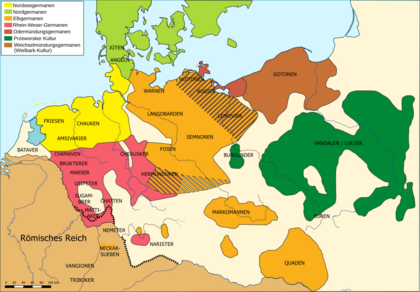
The most dangerous invasion was by the Marcomanni in the west. Their leader, Ballomar, had brought many Germanic tribes together. They crossed the Danube and won a big victory. This happened near Carnuntum, where they defeated 20,000 Roman soldiers. This battle is sometimes called the Battle of Carnuntum.
Ballomar then led most of his army south towards Italy. The rest of his army attacked Noricum. The Marcomanni destroyed Opitergium and surrounded the city of Aquileia. This was the first time enemy forces had entered Italy since 101 BC. The Roman army tried to help Aquileia but was defeated.
Historians disagree on the exact year of this big Germanic invasion into Italy. Some say it was 167 AD, while others say 170 AD. It was a very serious moment for the Roman Empire.
Roman Counter-Attack and Defeating the Marcomanni
This disaster made Marcus Aurelius change his plans. Roman forces from different borders were sent to fight Ballomar. They were led by Claudius Pompeianus, with the future emperor Pertinax as one of his officers. Rome also created a new military command to protect the roads into Italy. The Roman fleet on the Danube River was made stronger.
Aquileia was saved. By the end of 171 AD, the invaders had been pushed out of Roman territory. Rome then started talking with different barbarian tribes. They wanted to make friends with some tribes before crossing the Danube. A peace treaty was signed with the Quadi and the Iazyges. The Hasdingi Vandals and Lacringi tribes even became Roman allies.
In 172 AD, the Romans crossed the Danube into Marcomannic land. The Romans were successful. They defeated the Marcomanni and their allies, the Varistae or Naristi and the Cotini. Because of this, Marcus Aurelius took the title "Germanicus" (meaning "victor over the Germans"). Coins were made with the words "Germania capta" ("Germany conquered"). During this campaign, Valao, the chief of the Naristi, was killed by the Roman General Marcus Valerius Maximianus.
In 173 AD, the Romans fought the Quadi. The Quadi had broken their peace treaty and helped their relatives. The Romans defeated them. During this campaign, a famous event happened, called the "miracle of the rain." It was later shown on the column of Marcus Aurelius and on coins.
According to one historian, the Roman army was surrounded by a larger Quadi force. The Romans were almost ready to give up because of the heat and thirst. But a sudden rain shower saved them. Lightning also struck the Quadi. People at the time believed this was a miracle from the gods. Some said an Egyptian magician prayed to Mercury. Christian writers said it was because Christians prayed.
In the same year, Didius Iulianus, a Roman commander, stopped another invasion. This was by the Chatti and the Hermunduri tribes. The Chauci also raided the coast of Gallia Belgica.
In 174 AD, the Romans marched against the Quadi again. The Quadi removed their pro-Roman king, Furtius. They put his rival, Ariogaesus, in his place. But Marcus Aurelius refused to accept him. He removed Ariogaesus and sent him away to Alexandria. By late 174 AD, the Quadi were fully defeated. They had to give hostages to Rome. They also had to provide soldiers for the Roman army. Roman forts were built in their territory.
After this, the Romans focused on the Iazyges tribe. They lived in the plain of the Tisza River. After some Roman victories, a treaty was signed in 175 AD. The Iazyges King Zanticus gave back 100,000 Roman prisoners. He also provided 8,000 cavalry soldiers for Rome. Most of these (5,500) were sent to Britain. After this, Marcus Aurelius took the victory title "Sarmaticus."
Marcus Aurelius might have planned to fight the remaining tribes. He wanted to create two new Roman provinces, Marcomannia and Sarmatia. These would have included parts of today's Czech Republic and Slovakia. But his plans were stopped. A Roman general named Avidius Cassius started a rebellion in the East.
Marcus Aurelius marched east with his army. He had help from soldiers from the Marcomanni, Quadi, and Naristi tribes. After the rebellion was put down, the emperor returned to Rome. He had not been in Rome for almost 8 years. On December 23, 176 AD, he and his son Commodus celebrated a joint triumph. This was for his victories over the Germans and Sarmatians. To remember this, the Aurelian Column was built, like Trajan's Column.
Second Marcomannic War: Renewed Fighting
The celebrations were short-lived. In 177 AD, the Quadi rebelled again. Soon after, the Marcomanni also rebelled. Marcus Aurelius went north again to start his second campaign against the Germans. He arrived in Carnuntum in August 178 AD. He began to put down the rebellion, first fighting the Marcomanni. Then he fought the Quadi between 179 and 180 AD.
Under the command of Marcus Valerius Maximianus, the Romans won a big battle against the Quadi. This happened near modern Trenčín, Slovakia. The Quadi were chased further into Greater Germania. Another Roman general, Publius Tarrutenius Paternus, won another big victory against them. But on March 17, 180 AD, Marcus Aurelius died in Vindobona (modern Vienna).
His son and new emperor, Commodus, was not interested in continuing the war. His generals advised him to keep fighting. But Commodus made a peace treaty with the Marcomanni and Quadi instead. He then left for Rome in early autumn 180 AD. He celebrated a triumph on October 22.
Third Marcomannic War: Final Operations
Fighting continued against the Iazyges, the Buri, and other tribes. These tribes were called "free Dacians" and lived between the Danube and Roman Dacia. Not much is known about this war. But Roman generals like Marcus Valerius Maximianus, Pescennius Niger, and Clodius Albinus were involved. The victories they achieved were enough for Emperor Commodus to claim the title "Germanicus Maximus" in mid-182 AD. An old inscription describes a campaign against the Germanic tribe of the Lugii or Burii.
What Happened After the Wars
The Marcomannic Wars showed that Rome's northern border was weak. After these wars, half of all Roman legions (16 out of 33) were placed along the Danube and Rhine rivers. Many Germans settled in Roman border areas. These included Dacia, Pannonia, Germany, and even Italy. This had happened before, but this time many more people settled.
Marcus Aurelius had planned to create two new provinces on the left bank of the Danube. These were Sarmatia and Marcomannia, covering parts of today's Czech Republic and Slovakia. Some Germans who settled in Ravenna even rebelled and took control of the city. Because of this, Marcus Aurelius decided not to bring more barbarian tribes into Italy. He even sent away those who had already been brought there.
The Germanic tribes were stopped for a while. But the Marcomannic Wars were just the beginning. They were a sign of the invasions that would eventually lead to the end of the Western Roman Empire in the 4th and 5th centuries.
Maps
Key: Red arrows: Romans. Green arrows: Marcomanns. Italy and Adriatic Sea at bottom left corner.
- First Marcomannic War
- Second Marcomannic War


